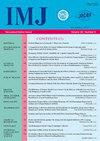PREVENTION OF INTRAOPERATIVE COMPLICATIONS IN PATIENTS WITH ACUTE AORTIC SYNDROME
Q4 Medicine
引用次数: 0
Abstract
Among the methods of treatment of acute aortic pathology in many cases, the surgery remains the method of choice. In order to improve the results of treatment for the patients with acute aortic syndrome by reducing the number of acute intraoperative lesions of organs and systems, a study was conducted, wherein there were analyzed the results of surgical treatment of 166 patients with thoracic and / or abdominal aortic lesions. The advantages of the developed and implemented in practice diagnostic and treatment algorithm for such patients in the pre−, intra− and postoperative periods have been considered. Upon admission to clinic, the main tasks were the maximum elucidation of the diagnosis and rapid structuring of surgery, which were started as soon as possible, primarily to control the blood loss. Hardware reinfusion of all blood lost from aortic rupture was mandatory. The most significant systemic complications were determined by cardiac, renal, respiratory and neurological ones. The proposed diagnostic and treatment algorithm has been concluded to be able of reducing the time and increase of the care efficiency for this category of patients. Programmed and systematic prevention of the most common and most dangerous intraoperative complications of acute aortic syndrome prevents their occurrence, reduces severity, improves the treatment outcomes. Intraoperative autohemotransfusion can reduce the total volume of blood loss, volume of infusion of donor drugs, and, consequently, frequency of acute kidney and lung injury in the intra− and early postoperative periods. The overall results of treatment for the patients with acute aortic syndrome largely depend on the experience of medical staff and equipment of a specialized hospital. Key words: aorta, acute aortic syndrome, aortic aneurysm, aortic dissection, surgical treatment, autohemotransfusion.急性主动脉综合征患者术中并发症的预防
在许多急性主动脉病变的治疗方法中,手术仍然是首选的方法。为了减少术中器官和系统的急性病变,提高急性主动脉综合征患者的治疗效果,本研究对166例胸腹主动脉病变患者的手术治疗结果进行了分析。在实践中开发和实施的诊断和治疗算法的优势,这类患者在术前,术中和术后期间已被考虑。入院后,主要任务是最大限度地阐明诊断和快速组织手术,尽快开始,主要是控制失血。硬体输注所有因主动脉破裂而流失的血液是强制性的。以心脏、肾脏、呼吸和神经系统并发症最为显著。本文提出的诊疗算法能够减少该类患者的就诊时间,提高护理效率。程序化和系统性地预防最常见和最危险的急性主动脉综合征术中并发症,预防其发生,降低严重程度,改善治疗效果。术中自体输血可以减少总失血量、供体药物输注量,从而减少术后早期急性肾和肺损伤的发生频率。急性主动脉综合征患者的整体治疗效果在很大程度上取决于专业医院医护人员的经验和设备。关键词:主动脉,急性主动脉综合征,主动脉瘤,主动脉夹层,手术治疗,自体输血。
本文章由计算机程序翻译,如有差异,请以英文原文为准。
求助全文
约1分钟内获得全文
求助全文
来源期刊

International Medical Journal
医学-医学:内科
自引率
0.00%
发文量
21
审稿时长
4-8 weeks
期刊介绍:
The International Medical Journal is intended to provide a multidisciplinary forum for the exchange of ideas and information among professionals concerned with medicine and related disciplines in the world. It is recognized that many other disciplines have an important contribution to make in furthering knowledge of the physical life and mental life and the Editors welcome relevant contributions from them.
The Editors and Publishers wish to encourage a dialogue among the experts from different countries whose diverse cultures afford interesting and challenging alternatives to existing theories and practices. Priority will therefore be given to articles which are oriented to an international perspective. The journal will publish reviews of high quality on contemporary issues, significant clinical studies, and conceptual contributions, as well as serve in the rapid dissemination of important and relevant research findings.
The International Medical Journal (IMJ) was first established in 1994.
 求助内容:
求助内容: 应助结果提醒方式:
应助结果提醒方式:


